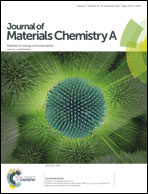Synthesis of 6H-benzo[c]chromene as a new electron-rich building block of conjugated alternating copolymers and its application to polymer solar cells†
Abstract
For the purpose of reducing the bandgap of a fluorene-based semiconducting polymer, we introduced a strong electron-donating oxygen atom into fluorene (F) to synthesize benzochromene (BC), which was then polymerized with electron deficient dithienyl benzothiadiazole (DTBT) and diketopyrrolopyrrole (DPP2T) to afford two low-bandgap polymers, PBCDTBT and PBCDPP2T, respectively. The PBCDTBT-based solar cell exhibits a high power conversion efficiency (PCE) of 5.74%, which is much higher than that of the reference polymer (PFDTBT) (2.56%). The higher PCEs of BC-based polymers are mainly attributed to higher JSC, which arises from stronger and broader absorption, higher exciton generation rate, more effective charge separation and higher hole mobility as compared to fluorene-based polymers.
![Graphical abstract: Synthesis of 6H-benzo[c]chromene as a new electron-rich building block of conjugated alternating copolymers and its application to polymer solar cells](/en/Image/Get?imageInfo.ImageType=GA&imageInfo.ImageIdentifier.ManuscriptID=C4TA02929A&imageInfo.ImageIdentifier.Year=2014)

 Please wait while we load your content...
Please wait while we load your content...